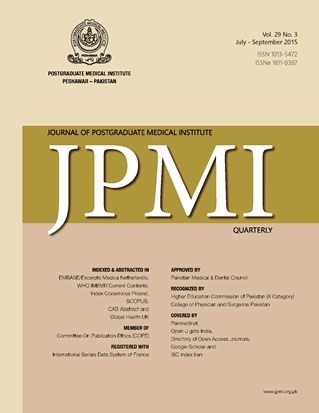SEASONAL VARIATION IN STROKE IN A TEACHING HOSPITAL OF KHYBER PAKHTUNKHWA
Main Article Content
Abstract
Objective: To determine seasonal variation in the occurrence of stroke and its
subtypes (ischemic stroke and hemorrhagic stroke) during summer and winter
and to observe the frequency of common risk factors for stroke.
Methodology: The present descriptive study was conducted in the Depart -ment of Medicine, MTI Lady Reading Hospital Peshawar, Khyber Pakhtunkhwa,
Pakistan, over a period of one year from 1st January 2014 to 31st December
2014. A total of 321 patients of any age and either gender were included. The
diagnosis was established based on history, clinical examination and supple-mented by CT scan of brain.
Results: In winter 58.56% of patients and in summer 41.48% of patients were
presented. Ischemic stroke was present in 66.04% patients while hemorrhagic
stroke in 33.95% patients. Males had more strokes as compared to females
(60.75% Vs. 39.25%). In males highest number of strokes was found in 60-69 age groups whereas in females it was in 50-59 age groups. In winter the
strokes increased in all age groups comparative to summer. Hypertension
(34.26%) was the highest risk factor for stroke.
Conclusion: Stroke showed seasonal variation. Winter season was associated
with increased frequency of stroke and its subtype of hemorrhagic stroke.
There was variation of gender, season and stroke types in different age groups.
Hypertension was found to be the highest risk factor.
subtypes (ischemic stroke and hemorrhagic stroke) during summer and winter
and to observe the frequency of common risk factors for stroke.
Methodology: The present descriptive study was conducted in the Depart -ment of Medicine, MTI Lady Reading Hospital Peshawar, Khyber Pakhtunkhwa,
Pakistan, over a period of one year from 1st January 2014 to 31st December
2014. A total of 321 patients of any age and either gender were included. The
diagnosis was established based on history, clinical examination and supple-mented by CT scan of brain.
Results: In winter 58.56% of patients and in summer 41.48% of patients were
presented. Ischemic stroke was present in 66.04% patients while hemorrhagic
stroke in 33.95% patients. Males had more strokes as compared to females
(60.75% Vs. 39.25%). In males highest number of strokes was found in 60-69 age groups whereas in females it was in 50-59 age groups. In winter the
strokes increased in all age groups comparative to summer. Hypertension
(34.26%) was the highest risk factor for stroke.
Conclusion: Stroke showed seasonal variation. Winter season was associated
with increased frequency of stroke and its subtype of hemorrhagic stroke.
There was variation of gender, season and stroke types in different age groups.
Hypertension was found to be the highest risk factor.
Article Details
How to Cite
1.
. Z, Iqbal N, shah ishfaq ahmad, Ali Z, Rehman H ur, Mehmood K. SEASONAL VARIATION IN STROKE IN A TEACHING HOSPITAL OF KHYBER PAKHTUNKHWA. J Postgrad Med Inst [Internet]. 2015 Dec. 12 [cited 2025 Dec. 14];29(3). Available from: https://jpmi.org.pk/index.php/jpmi/article/view/1850
Issue
Section
Original Article
Work published in JPMI is licensed under a
Creative Commons Attribution-NonCommercial 2.0 Generic License.
Authors are permitted and encouraged to post their work online (e.g., in institutional repositories or on their website) prior to and during the submission process, as it can lead to productive exchanges, as well as earlier and greater citation of published work.


